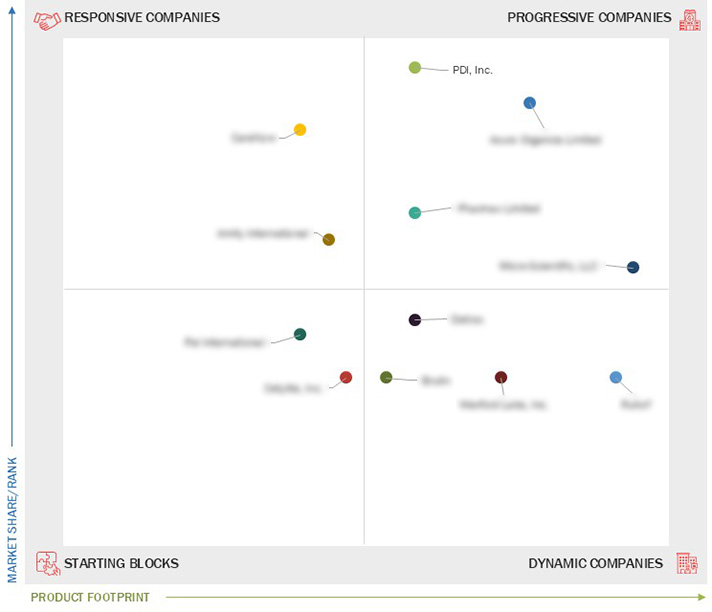Comparing 12 vendors in Surface Disinfectant Startups across 0 criteria.
A surface disinfectant is an antimicrobial agent applied to the surface of objects to eliminate microorganisms. Surface disinfectants play a vital role in this process by removing pathogens and germs, thereby ensuring effective protection against infections. Surface disinfectants are primarily used to clean walls, floors, and other surfaces in hospitals, as well as to disinfect medical devices and instruments.
Market Leadership Quadrant
1.1 Study Objectives
1.2 Market Definition
1.3 Study Scope
1.3.1 Markets Covered and Regional Scope
1.3.2 Inclusions and Exclusions
1.3.3 Years Considered
1.4 Currency Considered
1.5 Unit Considered
1.6 Limitations
1.7 Stakeholders
2.1 Introduction
2.2 Market Dynamics
2.2.1 Drivers
2.2.1.1 Growing focus on mitigating hospital-acquired infections
2.2.1.2 Rising adoption of advanced surface disinfectants for sanitization
2.2.1.3 Growing consumer awareness of hygiene in healthcare settings
2.2.1.4 Increasing surgical procedures worldwide
2.2.2 Restraints
2.2.2.1 Potential consequences of chemical disinfectant use
2.2.2.2 Increasing adoption of alternative surface disinfection methods
2.2.3 Opportunities
2.2.3.1 Rising healthcare expenditure in emerging economies
2.2.3.2 Shift toward eco-friendly and non-toxic disinfectants
2.2.3.3 Increasing presence of medical device and pharmaceutical companies in developing countries
2.2.4 Challenges
2.2.4.1 Strict regulatory requirements
2.3 Trends/Disruptions Impacting Customer Business
2.4 Value Chain Analysis
2.5 Ecosystem Analysis
2.6 Investment and Funding Scenario
2.7 Technology Analysis
2.7.1 Key Technologies
2.7.2 Complementary Technologies
2.7.3 Adjacent Technologies
2.8 Patent Analysis
2.9 Trade Analysis
2.10 Porter’s Five Forces Analysis
2.10.1 Threat of New Entrants
2.10.2 Threat of Substitutes
2.10.3 Bargaining Power of Suppliers
2.10.4 Bargaining Power of Buyers
2.10.5 Intensity of Competitive Rivalry
3.1 Introduction
3.2 Key Player Strategies/Right to Win
3.3 Revenue Analysis
3.4 Market Share Analysis
3.5 Company Valuation and Financial Metrics
3.6 Brand/Product Comparison
3.7 Company Evaluation Matrix: Startups/SMEs
3.7.1 Progressive Companies
3.7.2 Responsive Companies
3.7.3 Dynamic Companies
3.7.4 Starting Blocks
3.7.5 Competitive Benchmarking: Startups/SMEs
3.7.5.1 Detailed list of key startups/SMEs
3.7.5.2 Competitive benchmarking of key startups/SMEs
3.8 Competitive Scenario
3.8.1 Product Launches
3.8.2 Deals
3.8.3 Expansions
3.8.4 Other Developments
4.1 Acuro Organics Limited
4.1.1 Business overview
4.1.2 Products/Solutions/Services offered
4.1.3 Recent developments
4.2 Pharmax Limited
4.2.1 Business overview
4.2.2 Products/Solutions/Services offered
4.2.3 Recent developments
4.3 PDI, Inc.
4.3.1 Business overview
4.3.2 Products/Solutions/Services offered
4.3.3 Recent developments
4.4 Micro-Scientific, LLC
4.4.1 Business overview
4.4.2 Products/Solutions/Services offered
4.4.3 Recent developments
4.5 CareNow
4.5.1 Business overview
4.5.2 Products/Solutions/Services offered
4.5.3 Recent developments
4.6 Amity International
4.6.1 Business overview
4.6.2 Products/Solutions/Services offered
4.6.3 Recent developments
4.7 Wexford Labs, Inc.
4.7.1 Business overview
4.7.2 Products/Solutions/Services offered
4.7.3 Recent developments
4.8 Detrox
4.8.1 Business overview
4.8.2 Products/Solutions/Services offered
4.8.3 Recent developments
4.9 Brulin
4.9.1 Business overview
4.9.2 Products/Solutions/Services offered
4.9.3 Recent developments
4.10 Ruhof
4.10.1 Business overview
4.10.2 Products/Solutions/Services offered
4.10.3 Recent developments
4.11 Cetylite, Inc.
4.11.1 Business overview
4.11.2 Products/Solutions/Services offered
4.11.3 Recent developments
4.12 Pal International
4.12.1 Business overview
4.12.2 Products/Solutions/Services offered
4.12.3 Recent developments


 Asset Finance International
Asset Finance International
 Jul 2023
Jul 2023

